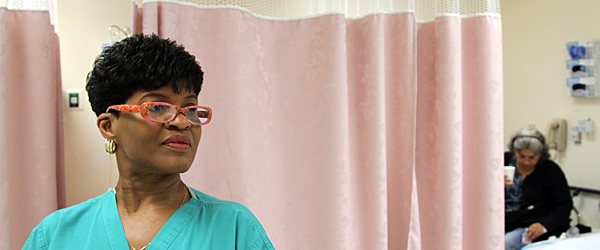Life After the Film Independent Spirit Awards: Checking In with The Waiting Room Director

Last year’s Truer than Fiction recipient was Pete Nicks for The Waiting Room, a character-driven documentary that goes behind the scenes of a public hospital struggling to care for a community of largely uninsured patients. Pete told us what the grant meant to him. “I can’t say it loudly enough, a grant like this is a remarkable gift for an independent filmmaker, especially at a moment when you’re working so hard to distribute and market and get attention for your last film, there’s no time to raise funds for your next project. Being an independent filmmaker is a crazy endeavor. So being supported at that critical moment, being validated by the industry and your peers is an incredible honor —and it enabled me to get going on my next project.”
Not only is Pete in pre-production on that next project, “the second of a trilogy of nonfiction films looking at the multiple dimensions of Oakland similar to how The Wire examined Baltimore,” but he’s also gearing up for the upcoming October 21, 10:00 pm national PBS broadcast of The Waiting Room.
“It’s been a long time coming,” said Pete. Originally slated for a year ago, the doc’s television broadcast premiere got pushed back to allow for what he calls its “little theatrical life.”
“The film had a very odd release all around. It stemmed from when we decided to release it independently through Kickstarter. The only way I could describe the theatrical run is serendipitous. Not predictable or planned. Every filmmaker wants to release theatrically, but it’s not up to their desire but whether the film is perceived to be commercial. We got rejected by 22 festivals initially, but we got into True/False, San Francisco, Hot Docs, Full Frame, AFI… so when those festivals started getting reviewed, we were reviewed really well and got a little life going.” Pete says that the audience and critical response to the film was so strong, they decided to launch a Kickstarter campaign with a goal of $75,000 to distribute it independently. They reached their goal and used the funding to cover the costs of getting the word out—advertising, posters, cutting the trailer—and most significantly allowed them to hire International Film Circuit agent Wendy Lidell, “and she started hustling the film.”
“I feel like when you have an underdog film, and you see how it is being reviewed, and know it has a compelling message and a compelling call to action. We were asking for quite a bit of money, and not many films had done this at that time. It was one of the first. In retrospect, it was crazy, seeing how difficult it is to raise money on Kickstarter, not for the Zach Braffs and Spike Lees, but for the rest of us. But I felt comfortable that we had a great trailer, festivals, awards and press, we had something to support the ask.”
“We did a quarter of a million theatrically, and with a unique roll out,” says Pete. The film opened in New York and L.A. on September 26, 2012, and though he says “we didn’t do remarkably well, we had such strong reviews, it kept it going, then here in the Bay Area it got some local love and just exploded. At the theater down the street from my house, it was beating Argo and Brave. That’s your dream to have your film at the local theater. It’s the theater I went to while I was in the doc program at Berkeley. So to see my film up there on the marquee was really special.”
The San Francisco buzz helped propel the film into Landmark Theaters and get into a national rollout. “Ultimately we were in 50 theaters over a period of several months. It bounced around like the stock market, but it did well for a film that didn’t have a lot marketing behind it.
The Waiting Room will get its Netflix and consumer DVD release timed around the PBS broadcast so the filmmakers can use the publicity around the broadcast to drive attention to the DVD.
Next up: the second of the trilogy, and Pete says he already has the development financing lined up. “It’s not exactly sequel but series of related films, so The Waiting Room has been incredibly useful in getting access to the institution where we’re making next film and for attracting the attention of funders.” Having a track record with an acclaimed film, he says has been “a huge help.”
“A lot of times [when it comes to financing], you’re taking a risk on an individual as opposed to just an idea. Having had the Spirit Awards and being short listed for an Oscar raises your profile….So when you’re seeking support, you can use your previous work to help communicate the idea and access…It’s one less hoop to jump through.”
By Pamela Miller / Grants and Website Manager
